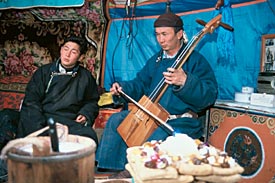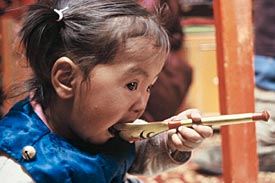The Story of the Weeping Camel
reviewed by anna battista
Directed by Byambasuren Davaa and Luigi Falorni.
 It's spring in the Mongolian Gobi Desert and the birthing season is approaching. A nomadic family of herders is helping one of their camels to give birth. The process is particularly painful, but the calf is beautiful and quite a rarity, indeed it is completely white. A problem arises though, its mother, traumatised by the birth, doesn't want it and rejects the poor baby camel whenever it cries and tries to get near her. The family tries to do anything for the mother camel to accept its baby, but, since nothing seems to work, they decide to send two of their sons, Dude and younger brother Usga to the Aimak Centre, which is fifty miles away from them, to look for a musician who could perform for them a Hoos ceremony. During this legendary ritual, a traumatised camel would be soothed into recovery by a folk musician, be healed and even weep.
It's spring in the Mongolian Gobi Desert and the birthing season is approaching. A nomadic family of herders is helping one of their camels to give birth. The process is particularly painful, but the calf is beautiful and quite a rarity, indeed it is completely white. A problem arises though, its mother, traumatised by the birth, doesn't want it and rejects the poor baby camel whenever it cries and tries to get near her. The family tries to do anything for the mother camel to accept its baby, but, since nothing seems to work, they decide to send two of their sons, Dude and younger brother Usga to the Aimak Centre, which is fifty miles away from them, to look for a musician who could perform for them a Hoos ceremony. During this legendary ritual, a traumatised camel would be soothed into recovery by a folk musician, be healed and even weep.
This is the plot of the film The Story of The Weeping Camel, co-directed by Mongolian Byambasuren Davaa, whose grandparents were nomads, and Italian Luigi Falorni. Born in Ulaanbaatar, Davaa enrolled in the Mongolian Film Academy and later went to Europe to study documentary production at the Munich Film School where she met Falorni. The film was basically a graduation project from the Hochschule für Fernsehen & Film in Munich, and its story is based on a movie Davaa remembered from her childhood, but it is also inspired by Robert Flaherty's Nanook of the North.
 The Story of the Weeping Camel contains some amazing scenes that portray the natural frightening beauty of Mongolia, its mountains and desert, its steppe and the violence of its dust storms. The film also gives and insight into the life of a Mongolian family, spanning four generations. Throughout the film, we follow the characters tending their camels and lambs, preparing the meals, playing with vertebrae-bone dice and telling stories to their kids. The family's life revolves around the ger, a collapsible, round tent of felt and canvas erected on a wooden frame, and around their livestock, camels in particular, which provide them life's basic necessities, blankets, ropes, milk and so on, apart for being the kids' favourite pets.
The Story of the Weeping Camel contains some amazing scenes that portray the natural frightening beauty of Mongolia, its mountains and desert, its steppe and the violence of its dust storms. The film also gives and insight into the life of a Mongolian family, spanning four generations. Throughout the film, we follow the characters tending their camels and lambs, preparing the meals, playing with vertebrae-bone dice and telling stories to their kids. The family's life revolves around the ger, a collapsible, round tent of felt and canvas erected on a wooden frame, and around their livestock, camels in particular, which provide them life's basic necessities, blankets, ropes, milk and so on, apart for being the kids' favourite pets.
Mother camel Ingen Temee and her white baby Botok are beautiful animals and, being this film miles away from a Hollywood set, they aren't portrayed as silly, cutesy icons and cartoon like characters. The two camels are fiery and wild animals, both deeply suffering from Botok's birth (note that the on-screen delivery is real) till the moment of the reconciliation. The film is not only about the camels, but also about the contrasts between the nomadic life of the family and the relentless progress: during the trip to the Aimak Centre, Usga will be so mesmerised by TVs and video games that as soon as he will be back he will convince his dad to get a TV set.
The Story of the Weeping Camel, Mongolia's first official Oscar candidate in the Best Foreign-Language Film category, is not a sociological study, it's more of a poetic ballad-cum-documentary, suspended between reality and legendary fiction.
Copyright (c) 2005 erasing clouds |
|